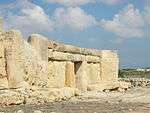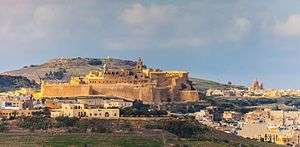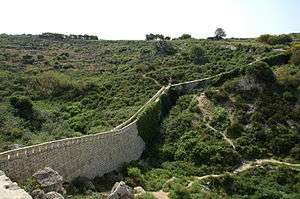List of World Heritage Sites in Malta
The United Nations Educational, Scientific and Cultural Organization (UNESCO) World Heritage Sites are places of importance to cultural or natural heritage as described in the UNESCO World Heritage Convention, established in 1972.[1] Malta ratified the convention on 14 November 1978, making its historical sites eligible for inclusion on the list.[2]
Sites in Malta were first inscribed on the list at the 4th Session of the World Heritage Committee, held in Paris, France in 1980. At that session, three sites were added: "Ħal Saflieni Hypogeum", "City of Valletta" and "Ġgantija Temples".[3] In 1992, the latter was renamed "Megalithic Temples of Malta", and was extended to include the temples of Ħaġar Qim, Mnajdra, Ta' Ħaġrat, Skorba and Tarxien.[4]
World Heritage Sites
The table lists information about each World Heritage Site:
- Name: as listed by the World Heritage Committee
- Location: city and region of site
- Area: size of property and buffer zone
- UNESCO data: the site's reference number; the year the site was inscribed on the World Heritage List; the criteria it was listed under: criteria i through vi are cultural, while vii through x are natural; (the column sorts by year added to the list)
- Description: brief description of the site
| Name | Image | Location | Area ha (acre) |
UNESCO data | Description |
|---|---|---|---|---|---|
| Ħal Saflieni Hypogeum |  |
Paola, 35°52′16.824″N 14°30′26.604″E / 35.87134000°N 14.50739000°E |
0.13 (0.32) | 130; 1980; iii | A large subterranean structure dating back to the Saflieni phase. It was probably originally a temple, but it became a necropolis in prehistoric times.[5] |
| City of Valletta |  |
Valletta, 35°54′2.016″N 14°30′51.984″E / 35.90056000°N 14.51444000°E |
56 (140) | 131; 1980; i, vi | A fortified city from the late Renaissance period, containing 320 monuments within a small area.[6] |
| Megalithic Temples of Malta |  |
Xagħra, Qrendi, Mġarr and Tarxien, 36°2′56.668″N 14°16′10.092″E / 36.04907444°N 14.26947000°E |
3.16 (7.8) | 132; 1980;[lower-alpha 1] iv | A series of prehistoric temples in various parts of the Maltese islands, which are among the oldest free-standing structures in the world.[7] |
Tentative List
In addition to the sites inscribed on the World Heritage list, member states can maintain a list of tentative sites that they may consider for nomination. Nominations for the World Heritage list are only accepted if the site has previously been listed on the tentative list.[8]
As of 2016, Malta was recording seven such sites on its tentative list. These sites, along with the year they were first included in the tentative list are:[2]
Notes
- ↑ Extended in 1992
References
- ↑ "The World Heritage Convention". UNESCO. Archived from the original on 1 April 2016.
- 1 2 "Malta". UNESCO. Archived from the original on 13 September 2015.
- ↑ "Report of the Rapporteur on the Fourth Session of the World Heritage Committee". UNESCO. 29 September 1980. Archived from the original on 24 March 2016.
- ↑ "Report of the Rapporteur on the Sixteenth Session of the World Heritage Committee". UNESCO. 14 December 1992. Archived from the original on 1 April 2016.
- ↑ "Ħal Saflieni Hypogeum". UNESCO. Archived from the original on 21 March 2016.
- ↑ "City of Valletta". UNESCO. Archived from the original on 3 April 2016.
- ↑ "Megalithic Temples of Malta". UNESCO. Archived from the original on 19 March 2016.
- ↑ "Tentative Lists". UNESCO. Archived from the original on 1 April 2016.
- ↑ "Coastal Cliffs". UNESCO. Archived from the original on 1 April 2016.
- ↑ "Qawra/Dwejra". UNESCO. Archived from the original on 1 April 2016.
- ↑ "Cittadella (Victoria – Gozo)". UNESCO. Archived from the original on 6 September 2015.
- ↑ "Knights' Fortifications around the Harbours of Malta". UNESCO. Archived from the original on 5 September 2015.
- ↑ "Mdina (Città Vecchia)". UNESCO. Archived from the original on 26 March 2016.
- ↑ "Coastal Cliffs". UNESCO. Archived from the original on 6 September 2015.
- ↑ "Victoria Lines Fortifications". UNESCO. Archived from the original on 24 March 2016.

.jpg)

_01_ies.jpg)


